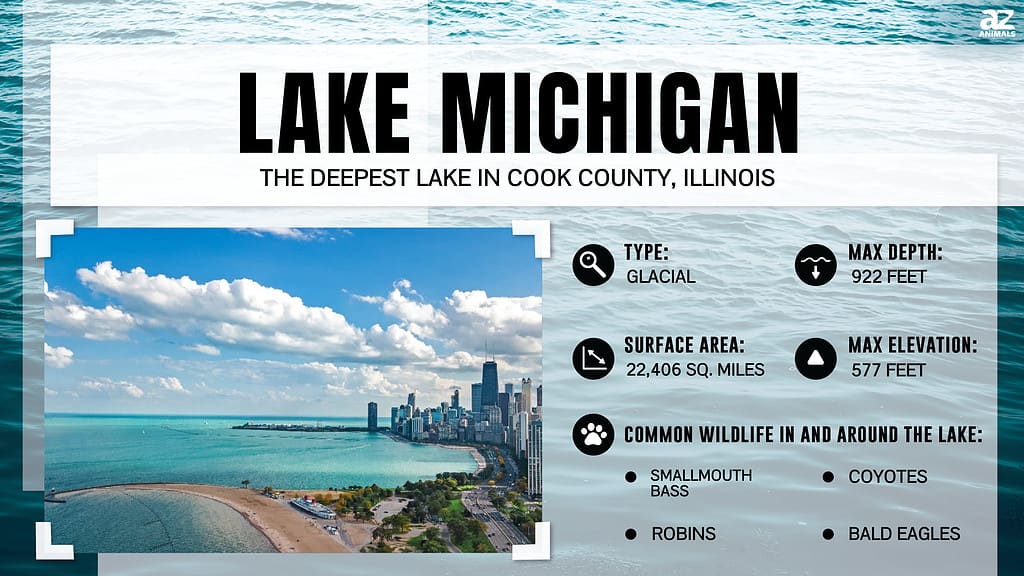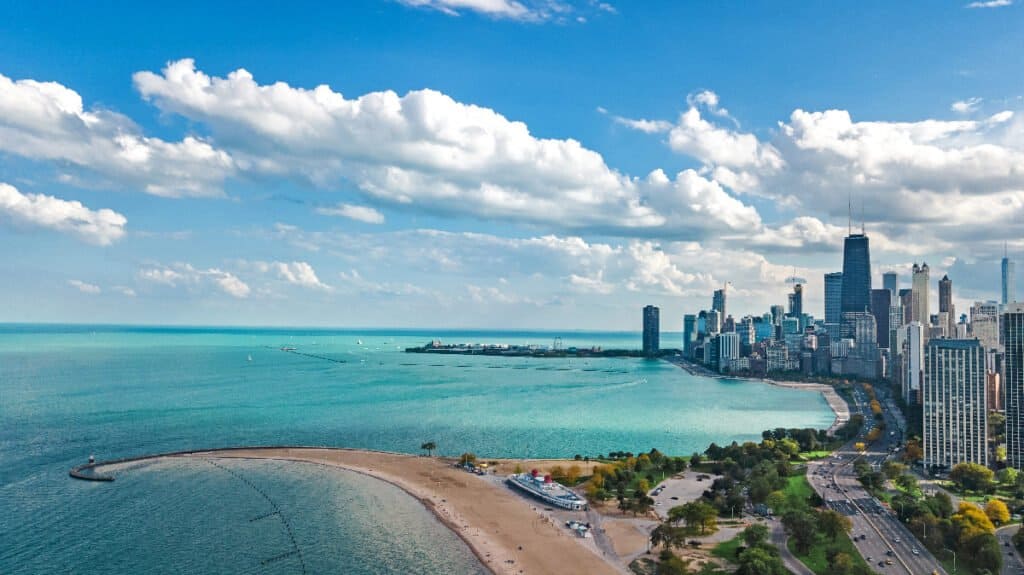Key Points:
- The deepest lake in Cook County is Lake Michigan, with incredible maximum depth of 922 feet.
- It is the third largest of the five Great Lakes of North America and has shorelines in four different states: Illinois, Indiana, Wisconsin, and Michigan.
- The lake’s waters were once so unpredictable and dangerous that many ships wrecked out in its depths before radar was invented in the 1940s.
Lakes are bodies of mostly freshwater surrounded by land but sometimes they are so large, you might imagine they go on forever into the horizon, releasing the sun every morning into the sky and welcoming it back every evening.
There is one such lake in Cook County, Illinois. Although the county has several gorgeous lakes, some smaller than others, there is one that stands out — not just because it’s the largest — it’s also the deepest lake in Cook County. Discover what makes this lake unique, the kinds of recreational activities you can enjoy in the area and the wildlife that calls this environment home.
Be sure to take note of a couple of other lakes worth a visit if you visit Cook County!

The Deepest Lake in Cook County
Lake Michigan is the deepest lake in Cook County at a staggering 922 feet deep. Lake Michigan’s depth makes it a magnificent attraction for those interested in water activities, including boating, fishing, and jet skiing.
Of the five Great Lakes of North America, it is the third largest. It is so large that it has shorelines in four different states, including Illinois Indiana, Wisconsin, and Michigan.
Chicago in Cook County enjoys 26 miles of gorgeous lakefront where there are tons of trails and beaches to explore. Although Chicago is the largest city on the edge of Lake Michigan, the lake also crosses into Lake County. Cook County takes up a total of 1,635 square miles, including the area where the lake is located. This county is the largest in the state of Illinois with 690 square miles made up of water.
Lake Michigan is so large that unless you knew it was a lake beforehand, you might just think you’re staring out into the ocean. It makes sense that its name was derived from mishigami, an Ojibwa Indian word that means “large lake.”

Chicago in Cook County enjoys 26 miles of lakefront thanks to Lake Michigan.
©JaySi/Shutterstock.com
Formation of Lake Michigan
Lake Michigan didn’t always have the inviting, sandy shoreline it boasts in Cook County today. Its formation began an unimaginable 1.2 billion years ago after two tectonic plates separated rather violently. This separation created what’s known today as the Mid-Continent Rift. In fact, this lake was so unpredictable and dangerous that many ships wrecked out in its depths before radar was invented in the 1940s. With radar and ships tasked with breaking ice, the passage through the lake has become much safer.
The edge of Lake Michigan was sandy with dunes and swampy wetlands. The development of the shoreline recognized today took several decades. It took thorough planning before the construction began. Material from the depths of Lake Michigan was used as well as sand from the shoreline in Indiana. To shield the newly developed environment, there had to be shoreline protection structures. With protection in place and a beautiful shoreline to appreciate, efforts turned toward further developing the land to add beaches, harbors, lagoons, parklands, and more.

Cook County takes up a total of 1,635 square miles, including the area where the lake is located.
©Sarah Michals/Shutterstock.com
Things To Do Near Lake Michigan
Aside from taking a dip in Lake Michigan, locals and visitors have several options for enjoying Chicago’s North Shore. A few of the locations around the lakefront for outdoor adventures include:
- Chicago Botanic Garden
- Emily Oaks Nature Center
- Evelyn Pease Tyner Interpretive Center
- Glencoe Beach
- Evanston Beaches
- Grove National Historic Landmark
- Ladd Memorial Arboretum and Evanston Ecology Center
- Northbrook Park District
- Forest Preserves of Cook County-River Trail Nature Center
- Winnetka Beaches.

Locations around the lakefront for outdoor adventures include the Chicago Botanic Garden.
©elesi/Shutterstock.com
Wildlife In and Around Lake Michigan
Since Lake Michigan encompasses a variety of different habitats, many wildlife species thrive throughout the area. There are not only sand dunes that rise up several hundred feet, but there are also forests, savannas, marshes, and tallgrass prairies. Some of the animals that enjoy the inside of the lake include fish species like smallmouth bass, salmon, trout, and walleye. There are also other aquatic animals like freshwater sponges, crawfish, sea lamprey, and some eel species. Birders can head out to Lake Michigan to spot robins, bald eagles, crows, and waterfowl like ducks and geese.
Throughout Chicago, even away from Lake Michigan’s shoreline, there are other animals that roam. Thousands of coyotes have made Cook County their home as well as deer, foxes, and skunks. Flying creatures in the area include bats, herons, and birds of prey. For more intentional encounters with the area’s wildlife, it’s worth checking out the parks, nature centers, and lakefront areas in Cook County.

Robins are among the many types of birds you will find around Lake Michigan.
©Bonnie Taylor Barry/Shutterstock.com
Other Notable Lakes in Cook County
It’s hard to beat Lake Michigan in Cook County, considering how expansive it is. But there are some other lakes in the area worth a visit. Rend Lake is also located in Chicago and covers a total of 19,000 acres, providing you with access to a wide range of recreational activities, including golf courses, biking trails, and camping sites. Maple Lake in Chicago is another great option, where you can enjoy 8,000 feet of shoreline and go fishing for northern pike, catfish, bluegill, and bass. You can also enjoy horseback riding, hiking, and biking as well as camping and boating.
Where Is Lake Michigan Located on a Map?
Lake Michigan is south of Lake Superior and west of Lake Huron. The cities of Chicago, Illinois; Gary, Indiana; and Milwaukee and Green Bay, Wisconsin are all ports on this huge lake in the north central part of the United States.
The photo featured at the top of this post is © iStock.com/Matt Sampson Photography
Thank you for reading! Have some feedback for us? Contact the AZ Animals editorial team.






